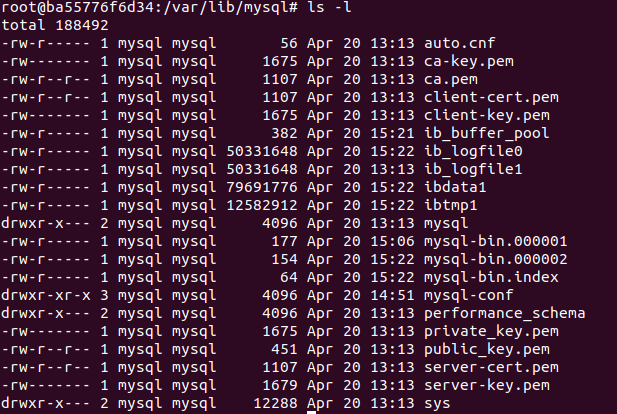0. precondition
a) install mysql 5.7, for detail please refer my blog post.
1. login mysql and check the variables to see if the binlog has been enabled.
mysql -h 127.0.0.1 -uroot -proot show variables like '%log_bin%';

we can see, the log_bin is disabled.
2. Turn on mysql log_bin
sudo vim /etc/mysql/conf.d/mysql.cnf
add the following config segment at the end of the file
# ---------------------------------------------- # Enable the binlog for replication & CDC # ---------------------------------------------- # Enable binary replication log and set the prefix, expiration, and log format. # The prefix is arbitrary, expiration can be short for integration tests but would # be longer on a production system. Row-level info is required for ingest to work. # Server ID is required, but this will vary on production systems server-id = 223344 log_bin = /var/lib/mysql/mysql-bin expire_logs_days = 3 binlog_format = row
#Mysql Packet Size may need to be re-configured. MySQL may have, by default, a ridiculously low allowable packet size.
#To increase it, you’ll need to have the property max_allowed_packet set to a higher number, say 1024M. max_allowed_packet=1024M
this configration means:
a) the server id is unique for each server, an is required for log_bin capture, it should be a numeric number equal or greater than 0, in my instance I set it to 223344, this number should be unique in the whole cluster. seems it's a good idea to set it as the ip
address number of the machine install. I fact I have do this in my real production enviroment.
b) the path of the log_bin, this is required to define the storage location fo the log_bin.
c) the log_bin retention time, in my case, I set it to 3 days.
d. the bin_log format, we should define it as row.
The whole definition file in my case is:

# For advice on how to change settings please see # http://dev.mysql.com/doc/refman/5.7/en/server-configuration-defaults.html [mysqld] # # Remove leading # and set to the amount of RAM for the most important data # cache in MySQL. Start at 70% of total RAM for dedicated server, else 10%. # innodb_buffer_pool_size = 128M # # Remove leading # to turn on a very important data integrity option: logging # changes to the binary log between backups. # log_bin # # Remove leading # to set options mainly useful for reporting servers. # The server defaults are faster for transactions and fast SELECTs. # Adjust sizes as needed, experiment to find the optimal values. # join_buffer_size = 128M # sort_buffer_size = 2M # read_rnd_buffer_size = 2M skip-host-cache skip-name-resolve #datadir=/var/lib/mysql #socket=/var/lib/mysql/mysql.sock #secure-file-priv=/var/lib/mysql-files user=mysql # Disabling symbolic-links is recommended to prevent assorted security risks symbolic-links=0 #log-error=/var/log/mysqld.log #pid-file=/var/run/mysqld/mysqld.pid # ---------------------------------------------- # Enable the binlog for replication & CDC # ---------------------------------------------- # Enable binary replication log and set the prefix, expiration, and log format. # The prefix is arbitrary, expiration can be short for integration tests but would # be longer on a production system. Row-level info is required for ingest to work. # Server ID is required, but this will vary on production systems server-id = 223344 log_bin = /var/lib/mysql/mysql-bin expire_logs_days = 3 binlog_format = row #Mysql Packet Size may need to be re-configured. MySQL may have, by default, a ridiculously low allowable packet size. #To increase it, you’ll need to have the property max_allowed_packet set to a higher number, say 1024M. max_allowed_packet=1024M #set default charactor set to utf-8 character-set-server=utf8 collation-server=utf8_unicode_ci
3. restart mysql service
systemctl restart mysql
after the mysql restarted, we use the command
show variables like '%log_bin%';
and we should found the log_bin is turned on now: log_bin | ON

then we go to file system, and can fould like this :

the log bin files are just there now!
-rw-r----- 1 mysql mysql 177 Apr 20 15:06 mysql-bin.000001
-rw-r----- 1 mysql mysql 154 Apr 20 15:22 mysql-bin.000002
-rw-r----- 1 mysql mysql 64 Apr 20 15:22 mysql-bin.index
In order to read mysql binlog, we need to grant the mysql user the following permissions:
-
SELECT -
RELOAD -
SHOW DATABASES -
REPLICATION SLAVE -
REPLICATION CLIENT
The first three privileges are required when reading a consistent snapshot of the databases. The last two privileges allow the database to read the server’s binlog that is normally used for MySQL replication.
you can see the permmission for the user by execute the following command in mysql terminal.
show grants for cdc-user ; -- cdc-user is the user name I used to do cdc synchronization.
the output is
--------------------------+ | Grants for cdc-user@% | +--------------------------------------------------------------------------------------------------------------------------------------------------------------------+ | GRANT RELOAD, PROCESS, ALTER, REPLICATION SLAVE, REPLICATION CLIENT ON *.* TO 'cdc-user'@'%' IDENTIFIED BY PASSWORD '*C8C6BD45F62159406C6E0587C42BDE28FFA5F973' | | GRANT SELECT, LOCK TABLES, SHOW VIEW ON `inventory`.* TO 'cdc-user'@'%' | | GRANT SELECT ON `mysql`.`help_relation` TO 'cdc-user'@'%' | | GRANT SELECT ON `mysql`.`time_zone_leap_second` TO 'cdc-user'@'%' | | GRANT SELECT ON `mysql`.`time_zone_name` TO 'cdc-user'@'%' | | GRANT SELECT ON `mysql`.`proc` TO 'cdc-user'@'%' | | GRANT SELECT ON `mysql`.`general_log` TO 'cdc-user'@'%' | | GRANT SELECT ON `mysql`.`slow_log` TO 'cdc-user'@'%' | | GRANT SELECT ON `mysql`.`func` TO 'cdc-user'@'%' | | GRANT SELECT ON `mysql`.`help_topic` TO 'cdc-user'@'%' | | GRANT SELECT ON `mysql`.`time_zone_transition_type` TO 'cdc-user'@'%' | | GRANT SELECT ON `mysql`.`event` TO 'cdc-user'@'%' | | GRANT SELECT ON `mysql`.`time_zone_transition` TO 'cdc-user'@'%' | | GRANT SELECT ON `mysql`.`time_zone` TO 'cdc-user'@'%' | | GRANT SELECT ON `mysql`.`help_keyword` TO 'cdc-user'@'%' | | GRANT SELECT ON `mysql`.`help_category` TO 'cdc-user'@'%' | +--------------------------------------------------------------------------------------------------------------------------------------------------------------------+
this indicate the user also need select permission for mysql database.
Notes: every time we restart the mysql server instance, it will call flush logs and then create a new binlog file.
